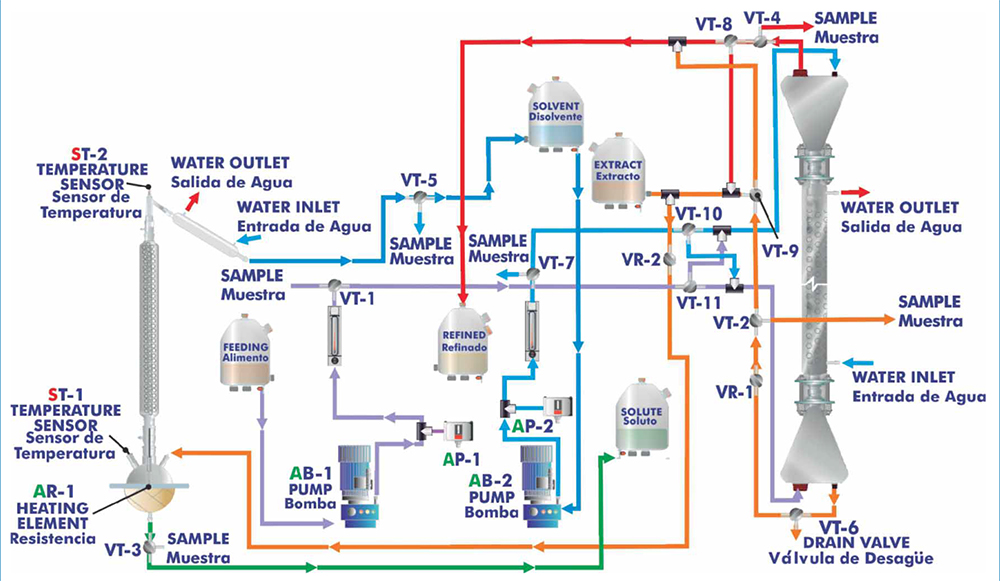The Liquid-Liquid Extraction Unit (UELL) is a laboratory scale unit designed to study the separation of the components of liquid mixtures by contact of the mixture with an immiscible solvent in which these components are preferentially soluble.
The extraction process is carried out in the glass liquid/liquid extraction column, which is composed of a jacketed glass packed column with two enlarged end sections. The joints between the three sections of the column are sealed with PTFE gaskets. The column isfilled with glass Raschig rings that are supported on a perforated PVC plate.
Feed for the column is stored in the feeding tank from where it is pumped by a diaphragm pump. It passes through a flowmeter and enters
the base section of the column via an injector mounted on it. Refine (phase with low content of solute) leaves the top of the column through a pipe and is collected in a refined tank.
The solvent supply tank provides the feed for a diaphragm pump. The solvent is pumped and passes through a flowmeter, then enters the top of the column via an injector. Extract (phase with high content of solute) leaves the bottom of the column through a pipe and is collected in an extract tank. A drain valve is fitted in the extract line.
The supply circuits and product collection circuits include two pressure switches that switch off the pumps when the pressure is high, two sampling taps to collect samples, three-way directional valves to direct the different currents and a regulation valve to control the height of the interface.
The distillation process is carried out in the distillation column boiler. The distillation column is made up of a glass section and contains Raschig rings made of glass. It is mounted closed to the extraction column and fitted at such a height that the solute may be drained into the solute tank.
Heating is done by means of a heating mantle in the base of the boiler. The boiler and the column head temperatures are indicated on two temperature sensors. The boiler lid is perforated where the distillation column is fitted and a pipeline allows to drain the extract from the extract tank. The boiler-solute tank circuit includes a sampling tap to collect samples.
The dissolvent vapour phase is condensed in the coolant column and re-cycled to the solvent tank to recovery the dissolvent andto provide a closed circuit. Then, the solvent can be re-cycled continuously.

|
1. - Preparation of acid–base titration of the feed. |
8. - Calculation of the mass transfer volumetric coefficient, referred to the continuous phase. |
| This is a floor-standing unit and includes wheels for its mobility. | |
| Anodized aluminum structure and panels in painted steel. | |
| Main metallic elements in stainless steel. | |
| Transparent elements for a better observation of the process. | |
| Diagram in the front panel with similar distribution to the elements in the real unit. | |
| Extraction process: |
Jacketed glass column packed with glass Raschig rings; length: 1200 mm and internal diameter: 50 mm. |
| Distillation process: |
Boiler for the distillation, heated by an electric heating mantle; capacity: 5 l. |
| 5 Pyrex storage tanks for the feed, refined, solvent, extract and solute. Capacity (each one): 10 l. They include drain valves. | |
|
Supply circuits and product collection circuits to connect the different components of the unit. They include 5 sampling taps, distributed between all the circuits of the unit, to control the process in all the pipelines of fluid, three-way directional valves, drainvalves and a regulating valve. |
|
| Two diaphragm pumps: |
Diaphragm pump with stainless steel head to pump the feed. Max. flow: 47 l./h, max. pressure: 5 bar. |
| Electrical heating mantle, power: 800 W. | |
| Two “J type” temperature sensors to measure the temperature in the column head and the boiler temperature in the distillation process | |
| Two flowmeters to measure the feed and solvent flow: |
Flowmeter for acetic acid 4%, range: 0-48 l./h |
|
The unit includes safety devices in the pumps to avoid shortcomings by overpressure. There are two pressure switches that switch off the pumps when the pressure is high. |
|
| Electronic console, including: |
2 switches for the diaphragm pumps (for the feed and for the solvent). |
| Cables and Accessories, for normal operation. | |
| Manuals |
This unit is supplied with the following manuals: Required Services, Assembly and Installation, Starting-up, Safety, Maintenance & Practices Manuals. |
|
- Electrical supply: single-phase, with ground, 220V./50Hz or 110V./60Hz. - Water supply and drain. - Air extraction system. |
| Dimensions |
1400 x 700 x 1950 mm. approx. (55.11 x 27.55 x 76.77 inches approx.). |
| Weight |
100 Kg. approx. (220 pounds approx.). |
Hiện tại chưa có ý kiến đánh giá nào về sản phẩm. Hãy là người đầu tiên chia sẻ cảm nhận của bạn.